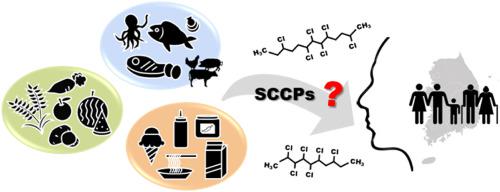当前位置:
X-MOL 学术
›
Environ. Pollut.
›
论文详情
Our official English website, www.x-mol.net, welcomes your
feedback! (Note: you will need to create a separate account there.)
Short-chain chlorinated paraffins in various foods from Republic of Korea: Levels, congener patterns, and human dietary exposure.
Environmental Pollution ( IF 7.6 ) Pub Date : 2020-04-04 , DOI: 10.1016/j.envpol.2020.114520 Sumin Lee 1 , Gyojin Choo 1 , Okon Dominic Ekpe 1 , Jongchul Kim 2 , Jeong-Eun Oh 1
Environmental Pollution ( IF 7.6 ) Pub Date : 2020-04-04 , DOI: 10.1016/j.envpol.2020.114520 Sumin Lee 1 , Gyojin Choo 1 , Okon Dominic Ekpe 1 , Jongchul Kim 2 , Jeong-Eun Oh 1
Affiliation

|
Short-chain chlorinated paraffin (SCCP) concentrations in 419 food samples (from 59 species) from Republic of Korea were determined. The SCCP concentrations and lipid contents in whole foods positively correlated and the highest SCCP concentration (891 ng/g wet weight) was observed in fats and oils. The SCCP concentrations were higher in benthic fish/shellfish and demersal fish than other fish and shellfish. The SCCP concentrations were higher in duck meat and eggs than meat and eggs of other species. The chlorine-based congener group patterns were related to the lipid contents of the foods. SCCPs in eggs (high lipid content) were dominated by more-chlorinated SCCPs (particularly Cl8-SCCPs, which contributed 43% of the total) but SCCPs in seaweed (low lipid content) were dominated by less-chlorinated SCCPs (particularly Cl6-SCCPs, which contributed 46%). Dietary SCCP intakes were calculated using the median SCCP concentrations and estimated 888 and 781 ng/kg/d for male and female Korean adults, respectively. The predominant contributing foods to SCCP dietary exposure differed according to sex and age. Dairy products contributed most (about 50%) for infants/children (1-5 y old), but meat and dairy products contributed most for adult males and females, respectively. Grain contributed most for ≥65 y old.
中文翻译:

大韩民国各种食品中的短链氯化石蜡:含量,同类物和人类饮食。
确定了来自大韩民国的419个食品样本(来自59个物种)中的短链氯化石蜡(SCCP)浓度。整个食品中的短链氯化石蜡浓度与脂质含量呈正相关,在油脂中观察到的短链氯化石蜡浓度最高(891 ng / g湿重)。底栖鱼类/贝类和沉鱼中的短链氯化石蜡浓度高于其他鱼类和贝类。鸭肉和鸡蛋中的短链氯化石蜡浓度高于其他物种的肉和鸡蛋。氯基同类物模式与食物中的脂质含量有关。鸡蛋中的短链氯化石蜡(高脂质含量)主要由氯化程度更高的短链氯化石蜡(特别是Cl8-SCCP占总含量的43%)主导,而海藻中的短链氯化石蜡(脂质含量低)则由低氯化度的短链氯化石蜡(特别是Cl6-SCCPs)主导,占46%)。饮食中短链氯化石蜡的摄入量是根据中型短链氯化石蜡的浓度计算得出的,韩国男性和女性的估计摄入量分别为888和781 ng / kg / d。SCCP饮食接触的主要贡献食物因性别和年龄而异。乳制品对婴幼儿(1-5岁)的贡献最大(约50%),而肉和乳制品对成年男性和女性的贡献最大。≥65岁,谷物贡献最大。但是肉类和奶制品分别对成年男性和女性贡献最大。≥65岁,谷物贡献最大。但是肉类和奶制品对成年男性和女性的贡献最大。≥65岁,谷物贡献最大。
更新日期:2020-04-20
中文翻译:

大韩民国各种食品中的短链氯化石蜡:含量,同类物和人类饮食。
确定了来自大韩民国的419个食品样本(来自59个物种)中的短链氯化石蜡(SCCP)浓度。整个食品中的短链氯化石蜡浓度与脂质含量呈正相关,在油脂中观察到的短链氯化石蜡浓度最高(891 ng / g湿重)。底栖鱼类/贝类和沉鱼中的短链氯化石蜡浓度高于其他鱼类和贝类。鸭肉和鸡蛋中的短链氯化石蜡浓度高于其他物种的肉和鸡蛋。氯基同类物模式与食物中的脂质含量有关。鸡蛋中的短链氯化石蜡(高脂质含量)主要由氯化程度更高的短链氯化石蜡(特别是Cl8-SCCP占总含量的43%)主导,而海藻中的短链氯化石蜡(脂质含量低)则由低氯化度的短链氯化石蜡(特别是Cl6-SCCPs)主导,占46%)。饮食中短链氯化石蜡的摄入量是根据中型短链氯化石蜡的浓度计算得出的,韩国男性和女性的估计摄入量分别为888和781 ng / kg / d。SCCP饮食接触的主要贡献食物因性别和年龄而异。乳制品对婴幼儿(1-5岁)的贡献最大(约50%),而肉和乳制品对成年男性和女性的贡献最大。≥65岁,谷物贡献最大。但是肉类和奶制品分别对成年男性和女性贡献最大。≥65岁,谷物贡献最大。但是肉类和奶制品对成年男性和女性的贡献最大。≥65岁,谷物贡献最大。











































 京公网安备 11010802027423号
京公网安备 11010802027423号